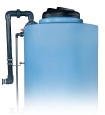The food and beverage industry has a long history of relying on stainless steel storage tanks due to the belief that the resins in a polyethylene storage tank allow leaching and bacterial growth with food dyes and other food products.
Topics:
Chemicals,
Applications
A double-wall pipe is an important safety tool when storing liquids, whether it’s chemicals, wastewater, or even liquids used in the food and beverage industry. The vast majority of double-walled piping applications are for wastewater chemicals, contaminated groundwater, and chemical process safety. Double-wall piping systems are used in a variety of ways to protect against leaks. When paired with a SAFE-Tank® system, it makes your storage solution even more secure.
Topics:
Fittings and Accessories,
Tank Design and Materials
When companies are purchasing a chemical storage tank, they often ask, “How long will the tank last?” We wish we could answer that question, but it’s a lot like asking, how long are you going to live? Just as a top athlete can die young from an injury and a lifelong smoker can live into their 90’s, there’s no way to predict exactly how long a specific chemical tank will last.
Safe water storage is important for both residential and commercial uses. In residential applications, homeowners capture rainwater for watering lawns and gardens. Water storage is necessary in a wide variety of commercial processes, including farming irrigation, livestock care, and cleaning.
Topics:
Applications
Sodium hypochlorite, or bleach, is one of the most commonly used chemicals across all industries. But that doesn’t mean you should use a common chemical storage system to contain this aggressive oxidizer. Whether you’re using a bleach concentration of 0.8%, 6%, or 12.5%, sodium hypochlorite will attack your storage tanks more aggressively than most other solutions. Without the proper storage tank system, you could be looking at a tank failure in less time than you expect.
Topics:
Chemical Storage
Bulk stored chemicals can become contaminated from two major sources: debris and moisture. As the product is emptied from the chemical storage tank, dirty air and moisture can be drawn into the tank. Temperature fluctuations can also cause the tank to expand and contract, so that it “breathes” contaminants in and out. Maintaining chemical purity is essential in many industrial chemical applications, such as computer chip manufacturing, food processing, clean in place, and pharmaceutical manufacturing. Contaminated chemicals can become less effective, and more hazardous to your storage equipment. To prevent contamination, Poly Processing often recommends installing special accessories. Tank vent dryers and desiccant filters may be your best choice for keeping moisture out of the chemical storage tank.
Topics:
Fittings and Accessories
You may spend a little more on a Poly Processing cross-linked polyethylene tank, but it could possibly cost much you more to own other tanks. Here’s why.
Topics:
Venting,
Fittings and Accessories,
Tank Design and Materials
Polyethylene chemical storage tanks are designed to expand and contract slightly in response to changes in temperature and internal pressure. But if your tank isn’t designed to handle the pressure it faces at key moments, you could be unknowingly setting yourself up for a tank failure.
Topics:
Venting
It’s hard to judge, with the naked eye, how a polyethylene tank is constructed. On the surface, a tank is just a tank. However, there is a big difference between a well-designed, properly constructed tank and a cheap one that doesn’t meet structural requirements.
Topics:
Certifications and Standards
One of the biggest advantages of polyethylene chemical storage tanks is their flexibility. Polyethylene tanks expand and contract with hydrostatic pressure changes during loading and unloading and during changing weather conditions. While a rigid tank is more susceptible to cracking and damage over time, a flexible tank is resilient.
Topics:
Fittings and Accessories,
Chemical Storage



